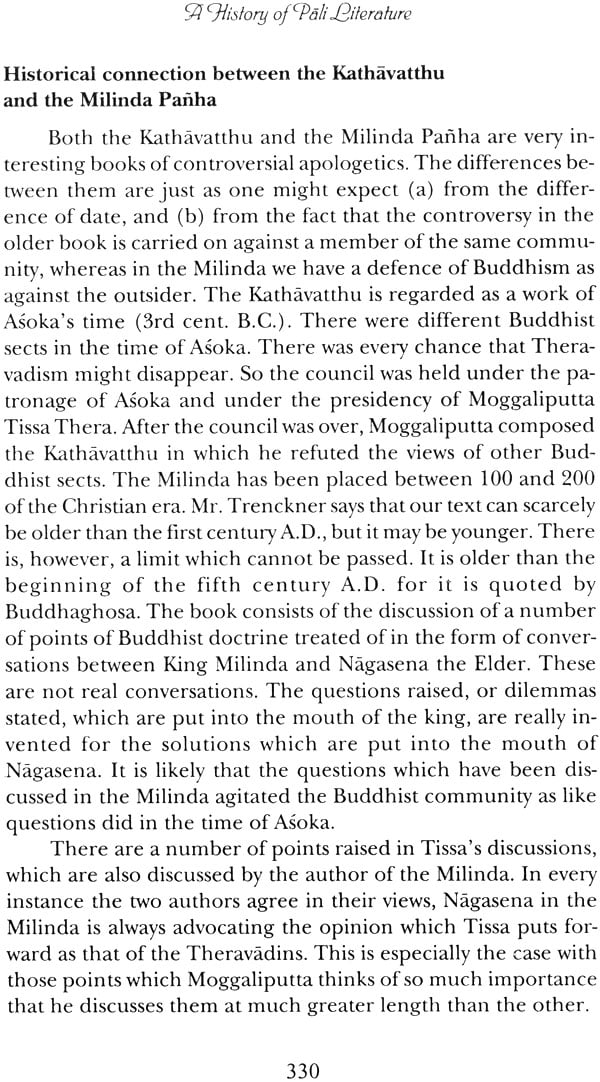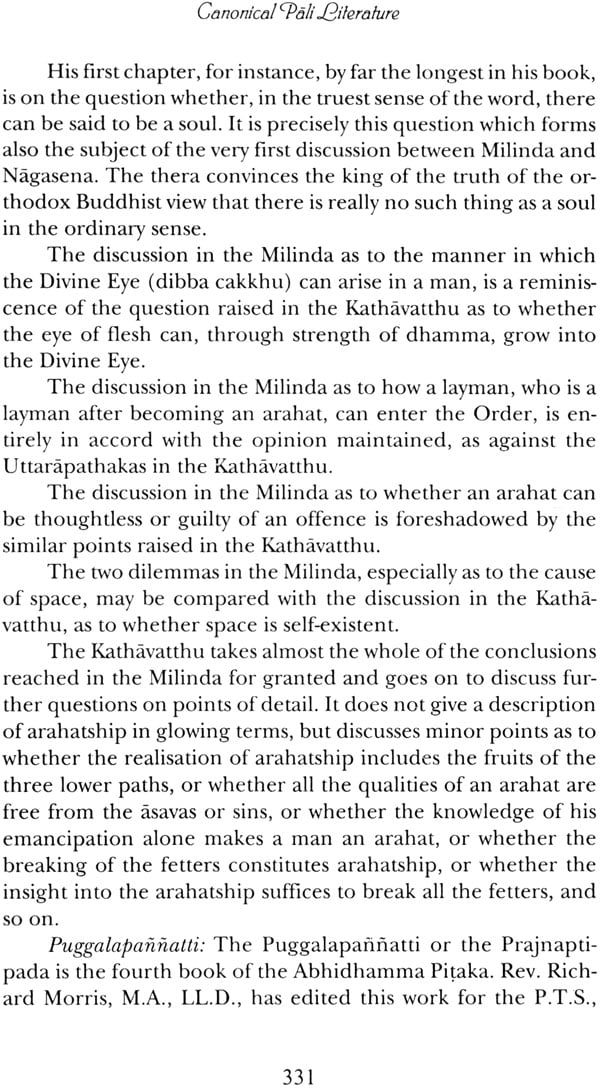
A HISTORY OF PALI LITERATURE
Book Specification
| Item Code: | IDD704 |
| Author: | Bimala Churn Law |
| Publisher: | Indica Books, Varanasi |
| Language: | English |
| Edition: | 2021 |
| ISBN: | 8186569189 |
| Pages: | 691 |
| Cover: | Hardcover |
| Other Details | 8.7 X 5.7 inch |
| Weight | 1.02 kg |
Book Description
The book, published for the first time in 2 volumes in 1933, has become a classic in Pali studies. It presents an exhaustive picture of the Pali literature, both canonical and post canonical, giving summaries of all the Pali books, from the Vinaya Pitaka, which specifies the rules of conduct for bikkhus andbikkhunis to the Jataka Tales containing popular stories. Here are presented the first Buddhist books in history, which became the scriptures that form the base for Theravada Buddhism.
Providing a huge amount of information about early Buddhism as well as about ancient Indian history this is an invaluable reference book for the scholar as well as for the general reader interested in Buddhism.
There can be no doubt that a new and ample treatment of the Pali literature is a great scientific want felt by all the scholars who are working in that field. Many problems connected with the subject are still unsolved. Not even the question of the origin and home of what we call Pali language and of its linguistic character is definitively settled and the chronological order of a single book is very often uncertain. Professor Winternitz in his great work on Indian literature has described also the Pali literature in an admirable manner. But the scope of his work did not allow him of course to enter into all the details and to discuss the many divergences of opinion. Malalasekera in his recent publication has confide himself of the Pali books composed in Ceylon. Hence the whole canonical literature was to be left aside. I was very much pleased therefore when I heard that Dr. Bimala Churn Law had intended to publish a comprehensive work on Pali Literature. We all know his former publications on Buddhist topics and their intrinsic value and I repeatedly congratulated him on the happy choice of his themes and on the clever manner in which he had accomplished his task. I was even more pleased when I had the opportunity to peruse a good deal of the manuscript of the present work. It will prove to be extremely useful to all the Pali Scholars by the sober and impartial judgemetn of the author and by the clear and exhaustive exposition of the various problems. Above all I wish to point at the important discussion of the relative chronology of the canonical texts which means a considerable progress beyond what Rhys Davids has said on the subject and at the ample and very clear summaries of the Tipitaka books which will be welcome to those who are unable to read them in the original language but wish to become acquainted with their general plan and contents. I frankly say that I found all I could read extremely suggestive and I am convinced that I shall learn much from the book even when my opinion may perhaps differs from that of the author.
Scholars interested in Buddhism have no doubt felt a great want of an exhaustive treatment of Pali literature. I have, therefore, attempted for the first time to supply the need of detailed and systematic history of Pali literature in two volumes. Drs. M.H. Bode and G.P. Malalasekera have published their respect the monographs on the Pãli literature of Burma and of Ceylon. Drs. Geiger and Winternitz have also given us a brief survey of Pãli literature in their respective works Pali Literature und sprache and Geschichte der Indischen Literature die Buddhistische literatur und die Heiligen texte derJ ainas (1920). But my treatment of the subject is entirely different from those of my predecessors. The first volume deals with the chronology and general history of the Pãli Pitakas. In the Introduction to this volume I have briefly discussed the origin of Pãli and the importance of the study of Päli as one of the Indian languages. A systematic and critical treatment of the puzzling problem of the chronology of the Pãli canon follows next, throwing a new light on this intricate and difficult subject. I have tried to discuss at some length the date and composition of each and every book included in the Pali canon. This volume contains a critical exposition of the Vinaya Pitaka. An elaborate treatment of the Sutta Pitaka consisting of the five nikayas, the Digha, Majjhima, Samyutta, Anguttara, and Khuddaka has received the attention it deserves. I have also taken care to point out the peculiarities of the style and language in which each suttanta has been written. Under each suttanta and under each nikaya the ancient and modern literafire hitherto published has been noticed. In the section on the Abbidhamma Pitaka, I have noted the significance and imporce of the Abhidhamma treatises not without paying attention: the style and language of the Abhidhamma texts. The Pãli counterparts of the Abhidharnma books of the Sarvastivada School have been dealt with in the last chapter of the first volume. I have everywhere considered it worth while to mention the available printed editions manuscripts and different recessions of each Sutta noting the points of textual variations wherever possible. An attempt has been made to collect the parallel passages by way of comparison from other literatures wherever found.
The second volume which treats of post canonical Pali literature is devoted to the study of extra canonical works presupposed by the Pali commentaries the Pali chronicles the Pali Manuals the Pali Literary piece the Pali Grammars lexicographies and works on rhetoric. In the concluding chapter. I have tired to give a general survey of the whole book and traced the development of Pali poetry. I have given two appendices dealing with the historical and geographical references in the Palin Pitakas and the Pali tracts int eh inscriptions which I believe will be found useful. I have appended an index at the end for the convenience of readers. I have not found it necessary to deal with some of the unimportant books about which nothing much can be known e.g the Sarasangaha (Containing may points concerning of Buddhims) the Kamandaki ( a Book on polity) the Akkharasammohachedea (word book) the SOtabhanalini (Containing edifying tales) the Takkabhasa a book on logic Amatakaravannana, Rajadhirajavilasini, Dhammasattapakrana, Dabbaguna (Pharmacology) Sarathasamgaha, Sulacaraka, Sadhucartodaya, Kosalabimbavannana, Sahassavatthupakarana Lokappadipakasara etc.
The task which I have performed is no doubt beset with difficulties but I shall consider my labor amply rewarded if this treatise is found useful by scholars interested in Buddhist Literature history and religion.
I am grateful to Mrs. Rhys Davids and Dr. B.M. Baruna for their valuable suggestions for the improvement of this work. Dr. W. Geiger has really laid me under a deep debt of gratitude by writing a foreword.
| Foreword | 5 | |
| Preface | 7 | |
| | ||
| Introduction | 11 | |
| Chapter 1 | Chronology of the Pali Canon | 29 |
| Chapter 2 | Canonical Pali Literature | 67 |
| Section I – Vinaya Pitaka | 67 | |
| Section II – Sutta Pitaka | 101 | |
| A. Digha Nikaya | 101 | |
| B. Majjhima Nikaya | 133 | |
| C. Samyutta Nikaya | 171 | |
| D. Anguttara Nikaya | 192 | |
| E. Khuddaka Nikaya | 204 | |
| Section III – Abhidhamma Pitaka | 309 | |
| Chapter 3 | Pali Counterparts of the seven Abhidhamma Treatise fo the sarvastivada School | 339 |
| | ||
| Introduction | 349 | |
| Chapter 4 | Extra Canonical works Presupposed by Pali Commentaries | 351 |
| Chapter 5 | Pali Commentaries | 387 |
| Chapter 6 | Pali Chronicles | 509 |
| Chapter 7 | Pali Manuals | 585 |
| Chapter 8 | Pali literary Pieces | 599 |
| Chapter 9 | Pali Grammers Lexicographies and works of prosody etc | 617 |
| Conclusion | 629 | |
| Appendix A | 635 | |
| Appendix B | 657 | |
| Index | 673 |







